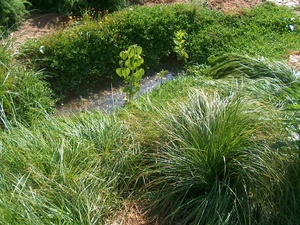 Clustered Field Sedge (Carex praegracilis) mingles with Yellow-Rayed Goldfields (Lasthenia glabrata) in a native plant garden.Sedges are members of the genus Carex in the sedge family (Cyperaceae). The sedge family also contains flatsedges, bulrushes, and spike rushes. The sedge family is closely related to the grass family, and sedges are commonly mistaken for grasses.
Clustered Field Sedge (Carex praegracilis) mingles with Yellow-Rayed Goldfields (Lasthenia glabrata) in a native plant garden.Sedges are members of the genus Carex in the sedge family (Cyperaceae). The sedge family also contains flatsedges, bulrushes, and spike rushes. The sedge family is closely related to the grass family, and sedges are commonly mistaken for grasses.
Native Species
Two sedge species are native to Woodland, and three more are native to other parts of Yolo County.
Native to Woodland
 Clustered Field Sedge (Carex praegracilis) in the foreground, with Sacramento Rose Mallow (Hibiscus lasiocarpos) in the drainage ditch behind it.Valley Sedge (Carex barbarae), also called Santa Barbara Sedge, is a two- to three-foot-tall evergreen perennial sedge that is native to all of Woodland, all of Davis, all of West Sacramento, and virtually all of Yolo County except for some narrow rain shadows just east of the Yolo County foothills and the Capay Hills. It prefers partial shade and slow drainage. It is equally likely to grow in wet or dry areas.
Clustered Field Sedge (Carex praegracilis) in the foreground, with Sacramento Rose Mallow (Hibiscus lasiocarpos) in the drainage ditch behind it.Valley Sedge (Carex barbarae), also called Santa Barbara Sedge, is a two- to three-foot-tall evergreen perennial sedge that is native to all of Woodland, all of Davis, all of West Sacramento, and virtually all of Yolo County except for some narrow rain shadows just east of the Yolo County foothills and the Capay Hills. It prefers partial shade and slow drainage. It is equally likely to grow in wet or dry areas.
Valley Sedge plants are usually monoecious (bearing both male and female flowers on the same plant). They are ranked 6 out of 10 on the Ogren Plant Allergy Scale, indicating a moderate tendency to cause hay fever.
Clustered Field Sedge (Carex praegracilis) is a two- to three-foot-tall evergreen perennial sedge that is native to all of Woodland, all of Davis, all of West Sacramento, and all of the area between them, as well as the eastern slopes of the Dunnigan Hills and from there eastward to Knights Landing, plus the northern Yolo County foothills, including the Capay Hills. It prefers full sun and is not picky about drainage. It usually grows in wet areas.
Clustered Field Sedge plants are often male or female but sometimes monoecious (bearing both male and female flowers on the same plant). Only the male and monoecious plants produce pollen. The male plants are ranked 8 out of 10 on the Ogren Plant Allergy Scale, indicating that they tend to cause fairly severe hay fever. The monoecious (androgynous) plants are ranked 6 out of 10, indicating a moderate tendency to cause hay fever.
Native to Yolo County
Lakeshore Sedge (Carex lenticularis), also called Goosegrass Sedge, is an eighteen-inch-tall perennial sedge that is native to Knights Landing. It prefers full sun and sandy or loamy soil. It grows only in wet areas.
Lakeshore Sedge plants are monoecious (bearing both male and female flowers on the same plant). They are ranked 6 out of 10 on the Ogren Plant Allergy Scale, indicating a moderate tendency to cause hay fever.
Rough Sedge (Carex senta), also called Swamp Sedge, is a perennial sedge that is native to the southern Yolo County foothills near Lake Berryessa. It prefers partial shade and standing water. It grows only in wet areas.
Rough Sedge plants are usually monoecious (bearing both male and female flowers on the same plant). They are ranked 6 out of 10 on the Ogren Plant Allergy Scale, indicating a moderate tendency to cause hay fever.


